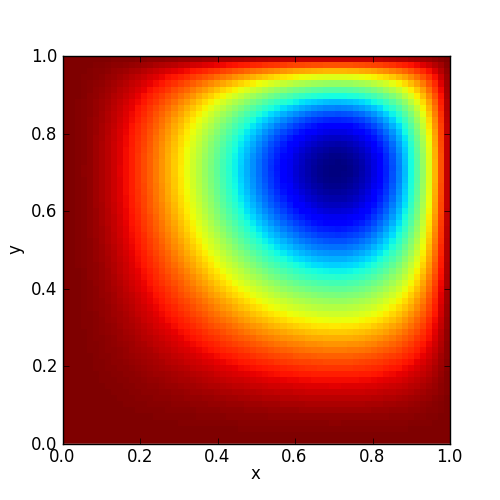Simple Multigrid Examples#
Known Solution#
A basic multigrid test is run as (using a path relative to the root of the
pyro2 repository):
./pyro/multigrid/examples/mg_test_simple.py
The mg_test_simple.py script solves a Poisson equation with a known analytic solution. This particular example comes from the text A Multigrid Tutorial, 2nd Ed., by Briggs. The example is:
on \([0,1] \times [0,1]\) with \(u = 0\) on the boundary.
The solution to this is shown below.

Since this has a known analytic solution:
We can assess the convergence of our solver by running at a variety of resolutions and computing the norm of the error with respect to the analytic solution. This is shown below:

The dotted line is 2nd order convergence, which we match perfectly.
The movie below shows the smoothing at each level to realize this solution:
You can run this example locally by running the mg_vis.py script:
./pyro/multigrid/examples/mg_vis.py
Projection#
Another example uses multigrid to extract the divergence free part of a velocity field. The script to run this is project_periodic.py. This is run as:
./pyro/multigrid/examples/project_periodic.py
Given a vector field, \(U\), we can decompose it into a divergence free part, \(U_d\), and the gradient of a scalar, \(\phi\):
We can project out the divergence free part by taking the divergence, leading to an elliptic equation:
The project-periodic.py script starts with a divergence free
velocity field, adds to it the gradient of a scalar, and then projects
it to recover the divergence free part. The error can found by
comparing the original velocity field to the recovered field. The
results are shown below:

Left is the original u velocity, middle is the modified field after adding the gradient of the scalar, and right is the recovered field.
Exercises#
Explorations#
Try doing just smoothing, no multigrid. Show that it still converges second order if you use enough iterations, but that the amount of time needed to get a solution is much greater.
Extensions#
Add a different bottom solver to the multigrid algorithm
Make the multigrid solver work for non-square domains
Implement the full-multigrid algorithm instead of just V-cycles
